Unlock the Secrets of Mount Hua: A Journey Through China’s Sacred Mountain
An Essential Guide to Visiting Mount Hua
Nestled in the heart of Shaanxi Province, Mount Hua (华山) stands as one of China’s five sacred mountains, renowned not just for its breathtaking beauty but also for its exhilarating and notoriously steep hiking trails. Often touted as the most dangerous in the world, this majestic peak offers adventurers a thrilling blend of natural splendor and cultural significance, making it a must-visit destination for intrepid travelers. Imagine traversing narrow ridges with sheer drops on either side, surrounded by ancient Taoist temples perched on rocky outcrops, all while soaking in panoramic views that stretch as far as the eye can see.
This essential guide to visiting Mount Hua will equip you with everything you need to embark on your own unforgettable journey. From practical information on ticketing and transport options to a detailed exploration of the five famous peaks, we’ll help you navigate the breathtaking trails and hidden gems of this iconic mountain. You’ll discover the best hiking routes tailored to your fitness level, uncover the rich history of the area, and learn about the must-see Taoist temples that dot the landscape. Whether you’re seeking adrenaline-pumping adventures or serene moments of reflection, Mount Hua promises an experience unlike any other. Get ready to lace up your hiking boots and prepare for an adventure that will leave you in awe!
In This Guide
- An Essential Guide to Visiting Mount Hua
- The Rich History and Legends of Mount Hua
- Main Highlights: What You Absolutely Can’t Miss
- Planning Your Visit: A Practical Guide
- Tickets: Prices, Booking, and Tips
- How to Get There: A Complete Transportation Guide
- Local Cuisine and Accommodation Nearby
- Frequently Asked Questions
- Final Thoughts on Your Trip
The Rich History and Legends of Mount Hua
Mount Hua, or Huashan, stands as a sentinel of ancient history and captivating legends, deeply interwoven with Chinese culture and spirituality. It is not merely a mountain; it is a revered site that has inspired poets, philosophers, and pilgrims for centuries.
The Ancient Beginnings
The history of Mount Hua dates back to the earliest dynasties of China, with its significance rooted in Taoism. The mountain was recognized as one of China’s Five Great Mountains, symbolizing the pinnacle of spirituality and natural beauty. Its highest peak, the South Peak, rises to 2,154.9 meters, making it an iconic landmark.
During the Han Dynasty (206 BC – 220 AD), Mount Hua emerged as a crucial site for religious pilgrimage. It was during this period that the mountain became a sanctuary for Taoist monks, who sought solitude and enlightenment amid its rugged cliffs and serene landscapes. Notably, the famous Taoist philosopher Laozi is said to have tread upon these very paths, further embedding the mountain in the spiritual fabric of Chinese history.
A Sanctuary of Legends
Mount Hua is steeped in legends that echo through its valleys and peaks. One of the most famous tales involves the goddess of the mountain, who is believed to guard the sacred land. It is said that those who climb to the peaks can hear her whispers in the wind, guiding and protecting them on their journey.
Another legend recounts the tale of a brave warrior who sought refuge on the mountain after being betrayed by his comrades. It is said that he was transformed into a mythical bird, soaring above the mountains as a guardian spirit for future travelers. This story resonates with the many adventurers who visit, seeking courage and strength to conquer the daunting trails that Mount Hua offers.
The Flourishing of Temples
As pilgrims flocked to Mount Hua, numerous temples sprung up, each with its own rich history. The Xiyue Temple, located at the foot of the mountain, is among the oldest and most revered. Built during the Tang Dynasty (618 – 907 AD), it served as a spiritual center for Taoists and remains a place of worship today. The temple’s architecture, with its intricate carvings and serene courtyards, reflects the craftsmanship and devotion of those who built it.
The Yuquan Temple, nestled amongst the peaks, is another notable site known for its tranquil atmosphere, making it a favorite among meditators. Legends speak of monks who attained enlightenment here, adding to the mountain’s mystical allure.
Mount Hua in the Modern Era
In more recent times, Mount Hua has become a popular destination for both domestic and international travelers. The recognition of its breathtaking landscapes and thrilling hiking trails has led to its preservation as a national park. Yet, despite the influx of visitors, the mountain retains its spiritual essence, continuing to attract those seeking adventure and tranquility alike.
Today, climbers can experience the adrenaline-pumping Plank Walk in the Sky, a route that follows the edge of steep cliffs, allowing them to immerse themselves in the natural beauty of Mount Hua while confronting their fears.
Echoes of the Past
As you traverse the trails of Mount Hua, you walk in the footsteps of those who came before—warriors, monks, and poets—each leaving a mark on the mountain’s storied history. The legends of Mount Hua continue to inspire, reminding us that this majestic mountain is not just a physical challenge but a journey into the heart of Chinese culture and spirituality. Whether you seek adventure, introspection, or simply to witness the stunning views, Mount Hua offers an experience that resonates with the rich tapestry of history and legend that surrounds it.
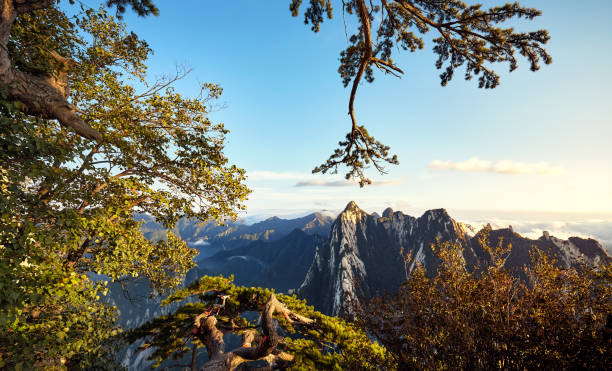
Mount Hua.
Main Highlights: What You Absolutely Can’t Miss
The Five Famous Peaks
Mount Hua boasts five distinct peaks, each offering its own unique perspective and experiences. The South Peak, at a towering 2,154.9 meters, is the highest and provides breathtaking panoramic views that will leave you in awe. The West Peak is often dubbed the most beautiful, known for its stunning natural beauty, while the East Peak is the prime spot for witnessing a mesmerizing sunrise. Don’t miss the North Peak for the best overall view of the mountain range, and the serene Middle Peak, surrounded by lush forests, perfect for quiet reflection. Plan your ascent early in the morning to witness the spectacular sunrise from East Peak or embark on an adventurous hike to explore all five peaks in a single day.
Chang Kong Zhan Dao: Plank Walk in the Sky
For thrill-seekers, the Plank Walk in the Sky is an absolute must. Located near the South Peak, this adrenaline-pumping trail clings to the side of a sheer cliff, offering heart-stopping views. You’ll navigate a narrow wooden plank path after descending a series of metal rods fashioned into a ladder. Safety harnesses are provided, but be prepared to test your nerves! This experience is not for the faint-hearted, so ensure you have a head for heights and sturdy shoes before undertaking this exhilarating challenge.
Qian Chi Zhuang: Thousand-Foot Precipice
Prepare for a true test of your climbing skills at Qian Chi Zhuang, a historic trail with steep stairs that date back to the Han Dynasty. This challenging route will require both hands and feet to traverse its 370 steps, culminating in a cave climb that adds to the adventure. The ancient stone steps are surrounded by breathtaking views, making every bit of effort worth it. Ensure you bring plenty of water and take breaks to enjoy the scenery along the way.
Taoist Temples
Mount Hua is steeped in spiritual significance, housing over twenty Taoist temples that reflect its rich religious heritage. Notable temples include Xiyue Temple, situated at the mountain’s base, which features impressive architecture and tranquil surroundings. Yuquan Temple is a pilgrimage site favored by those seeking meditation and peace. Don’t forget to explore Zhenye Palace for its stunning architecture and serene atmosphere, ideal for moments of quiet contemplation amidst the hustle of your hike.
Green Dragon Ridge: Cang Long Ling
For those who aren’t afraid of heights, Green Dragon Ridge offers an exhilarating walk along a narrow ridge with steep drops on either side. The trail’s name reflects its resemblance to a dragon’s back, and the views from this height are simply unforgettable. Just remember to keep your balance and take your time navigating this breathtaking route. Make sure to wear non-slip shoes and stay hydrated while enjoying the stunning vistas.
Yao Zi Fan Shen: Sparrow Hawk Turn
If you’re an experienced climber, the Sparrow Hawk Turn will provide the challenge you crave. This steep climb requires some serious effort as you pull yourself up on chains. The effort is rewarded with stunning views, particularly from the nearby Chess Pavilion. Before attempting this route, ensure you’re in good physical shape and bring gear that can assist with the climb, such as gloves for better grip.
Sunset at South Peak
As the day winds down, make your way to South Peak for a spectacular sunset. The vibrant colors painting the sky as the sun dips below the horizon create a mesmerizing backdrop that’s perfect for photography and reflection. Bring a light jacket, as temperatures can drop significantly in the evening. Arriving early will allow you to secure a good spot and soak in the breathtaking views as day turns to night.
Practical Tips
- Cable Car Access: If you prefer a less strenuous ascent, consider using the cable car, which operates from 8 a.m. to 6 p.m. This can help conserve your energy for hiking and exploring the peaks.
- What to Pack: Comfortable hiking shoes, layered clothing, snacks, and plenty of water are essential for a successful trip. A small backpack will help you carry your gear efficiently.
- Getting There: The high-speed train from Xi’an to Huashan North Station is the quickest option, taking just 30-40 minutes. Free shuttles are available from the station to the park entrance.
Mount Hua promises an unforgettable experience filled with stunning landscapes, thrilling adventures, and a touch of spirituality. Whether you’re an avid hiker or simply looking to soak in breathtaking views, this sacred mountain offers something for everyone.
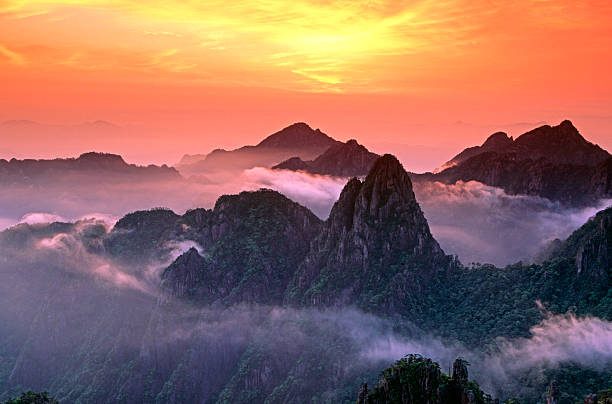
Mount Hua.
Planning Your Visit: A Practical Guide
Best Time to Visit
The ideal months to visit Mount Hua are from March to November when the weather is milder and the hiking trails are more accessible. Spring (April to June) is particularly beautiful as the flora is in bloom, while autumn (September to November) offers stunning foliage. Summer can be hot, but the mountain’s altitude provides a cooler respite. Winter (December to February) is less crowded but can be cold and icy, so be prepared for challenging conditions if you choose to hike during this time.
Recommended Itinerary
Day Trip Itinerary:
1. Morning:
– Depart from Xi’an North Railway Station by high-speed train (30 minutes).
– Take a free shuttle to the visitor center.
– Start your hike at the North Gate or take the West Peak Cableway to save time.
- Midday:
- Explore South Peak, the highest point, for breathtaking views.
-
Enjoy lunch at one of the mountain restaurants or pack a picnic.
-
Afternoon:
- Hike to East Peak for the sunrise views (if you’re spending the night) or continue exploring the other peaks.
-
Consider challenging routes like Plank Walk in the Sky or the Sparrow Hawk Turn if you’re adventurous.
-
Evening:
- Descend via the North Peak Cableway or hike back down for more views.
- Return to Xi’an for dinner and relaxation.
Photography Tips
- Golden Hour: Sunrise and sunset offer the best lighting. East Peak is the perfect spot for sunrise shots.
- Wide-Angle Lens: Capture the sweeping landscapes and dramatic cliffs.
- Safety First: If you’re attempting the Plank Walk, secure your camera with a strap to avoid drops.
- Diverse Angles: Experiment with different perspectives, especially from cliff edges and various peaks to showcase the mountain’s grandeur.
- People in Frame: Include fellow hikers to convey the scale of the mountain and the adventure.
What to Wear
- Footwear: Sturdy, comfortable hiking boots are essential for navigating the steep and rocky trails.
- Layers: Temperatures can vary significantly. Start with a moisture-wicking base layer, add an insulating layer, and finish with a waterproof jacket.
- Accessories: Don’t forget a hat, sunglasses, and sunscreen to protect against the sun. Gloves can be useful in cooler months.
- Backpack: Bring a small daypack for essentials like water, snacks, and a first-aid kit.
Insider Tips
-
Stay Overnight: Consider staying in mountain accommodations to experience sunrise and sunset at South Peak without the rush of day-trippers.
-
Hydration is Key: The altitude can be demanding, so drink plenty of water throughout your hike. Carry a reusable water bottle to refill at designated stations.
-
Avoid Weekends and Holidays: If possible, plan your visit on weekdays to avoid the large crowds typical during weekends and Chinese holidays.
-
Respect Nature and Culture: Mount Hua is rich in Taoist history. Take time to visit the temples, and be respectful of the spiritual significance of the area.
-
Plan for Safety: Some trails have age and health restrictions. Always check current conditions and trail requirements before embarking on your hike.
With its stunning views and exhilarating trails, a visit to Mount Hua promises to be a memorable adventure. Prepare well, respect the environment, and enjoy the breathtaking landscapes that await you!
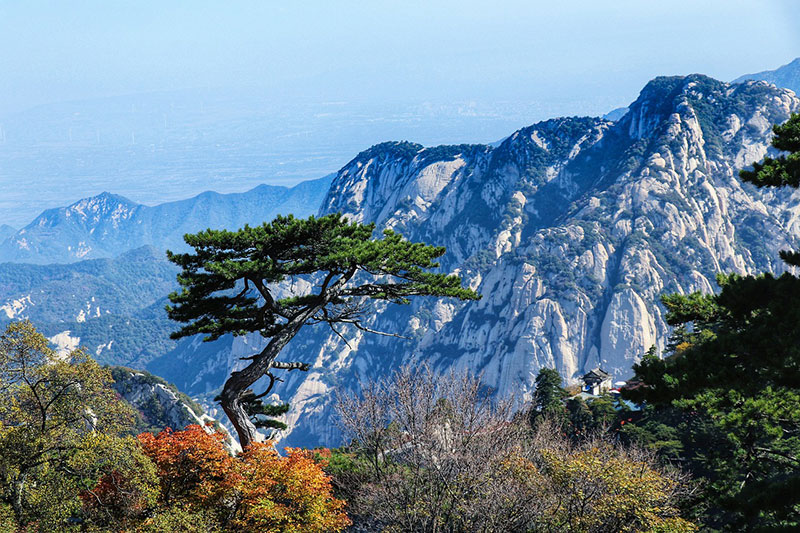
Mount Hua.
Tickets: Prices, Booking, and Tips
When planning your adventure to Mount Hua, understanding the ticketing options is essential for a smooth experience. Below is a summary of the available tickets, prices, and what each ticket includes.
| Ticket Type | Price (CNY) | Includes |
|---|---|---|
| Entrance Ticket | 160 | Access to the mountain for 48 hours (Mar-Nov) |
| Entrance Ticket | 100 | Access to the mountain for 48 hours (Dec-Feb) |
| Cable Car Ticket | Varies | One-way or round-trip access (West Peak or North Peak) |
| Shuttle Bus Ticket | Varies | Transportation from the Huashan North Station to the visitor center |
Booking Information
Tickets can be purchased at the Huashan Visitor Center located at the base of the mountain. It’s advisable to book your tickets in advance, especially during peak travel seasons from March to November when visitor numbers can surge. This way, you can secure your spot and avoid long queues.
If you prefer a hassle-free experience, consider booking through a travel agency that can assist with both ticket purchases and transportation arrangements. Many agencies offer packages that include guided tours, which can enhance your visit by providing insights into the cultural significance of Mount Hua and ensuring you make the most of your time on the mountain.
Tips for a Smooth Experience
- Book Early: Given the popularity of Mount Hua, especially during holidays and weekends, booking your tickets ahead of time is essential.
- Check for Additional Fees: Some attractions, like the Plank Walk in the Sky, may require an additional ticket. Ensure you have all necessary tickets to avoid surprises.
- Travel During Off-Peak Hours: If possible, try to visit on weekdays or early in the morning to enjoy a quieter experience.
By planning ahead and securing your tickets in advance, you can focus on what truly matters: enjoying the breathtaking views and exhilarating hikes that Mount Hua has to offer!
How to Get There: A Complete Transportation Guide
From the Nearest Major City
Traveling from Xi’an
High-Speed Train
The most efficient and comfortable way to reach Mount Hua from Xi’an is by high-speed train. Depart from Xi’an North Railway Station, with trains operating frequently throughout the day. The journey takes between 30 to 40 minutes, with ticket prices around 100 RMB (approximately $15 USD). The first trains typically leave around 7 a.m., so you’ll have ample time to enjoy your day on the mountain. Upon arrival at Huashan North Station, free shuttle buses (lines 1 and 2) will take you to the park gates in about 20 minutes. If the buses are crowded, taxis are readily available for around 20-30 RMB.
Regular Train
Though the high-speed train is preferred, you can also opt for a regular train service, which takes over 2 hours. This option is less convenient and may not offer the same level of comfort.
Private Driver
If you’re traveling with a group or prefer a more personalized experience, hiring a private driver is a viable option. This can be more expensive than taking the train, but it allows for flexibility in departure times and can make for a more comfortable journey, especially if you wish to leave early to beat the crowds.
Organized Tours
For those looking for a hassle-free experience, consider joining an organized tour from Xi’an. These tours typically include private transportation and an English-speaking guide, though note that cable car tickets are usually not included in the package.
Traveling from Other Major Cities
From Chengdu
Traveling from Chengdu to Mount Hua is best done by train. Expect to spend around 400 RMB for a second-class ticket on a journey that takes approximately 4.5 to 5 hours. Always check current schedules and book tickets in advance.
From Beijing
If you’re starting from Beijing, the train is again the most reliable option. The travel time is about 5 hours, with tickets costing around 600 RMB. As with Chengdu, it’s advisable to book your tickets ahead of time, especially during peak travel seasons.
By Plane
Flying to Mount Hua is not recommended due to the lack of nearby airports. The time and cost associated with flying, plus the need for additional ground transport, make train travel a far more practical choice.
Getting Around the Scenic Area
Once you arrive at Mount Hua, navigating the scenic area is relatively straightforward. Here are your primary options:
Cable Cars
Mount Hua features two main cable car routes—the West Peak Cableway and the North Peak Cableway.
– West Peak Cableway: This route takes you up to the West Peak, which is known for its beautiful views. Operating hours are from 8 a.m. to 6 p.m.
– North Peak Cableway: A shorter option, this cable car is ideal for those who may be less comfortable with heights.
Hiking Trails
The mountain is renowned for its steep hiking trails and breathtaking views. Be prepared to hike extensively, as many of the most stunning vistas and temple sites are only accessible on foot. The main hiking routes include:
– Yuquan Temple to North Peak: A challenging hike leading to several peaks, perfect for adventurous travelers.
– Classic Route: Utilizing the West Peak Cableway to ascend, followed by a hike across the peaks and descent via the North Peak Cableway.
Shuttle Buses
Within the scenic area, free shuttle buses operate between various points of interest, including the visitor center and park gates. This service is particularly useful if you wish to conserve energy for hiking.
Walking
Many visitors enjoy exploring the area by foot. The paths are well-marked, and you’ll encounter numerous temples and viewpoints along the way. Just be sure to wear sturdy hiking boots and bring sufficient water.
Safety and Tips
- Tickets: Entrance tickets to Mount Hua are valid for 48 hours and cost 160 RMB from March to November and 100 RMB from December to February.
- Altitude Awareness: Remember that Mount Hua stands at 2,154.9 meters, so acclimatization may be necessary for some travelers.
- Weather Preparedness: Temperatures can vary significantly, especially at higher altitudes, so pack layers, including warm socks and boots.
With proper planning, your journey to Mount Hua can be both exciting and memorable. Enjoy the stunning landscapes and unique cultural experiences that await you on this sacred mountain!
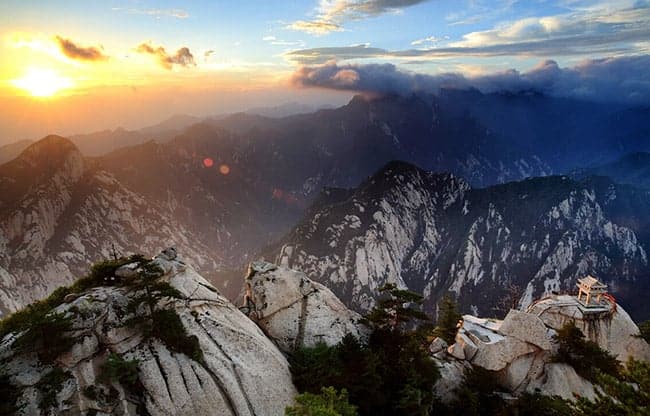
Mount Hua.
Local Cuisine and Accommodation Nearby
When visiting Mount Hua, indulging in the local cuisine and selecting the right accommodation can significantly enhance your travel experience. Here’s a guide to some delightful dishes to try and a range of lodging options to suit various budgets and preferences.
Culinary Delights
-
Biang Biang Noodles (刀削面)
A specialty of Shaanxi Province, these wide, hand-pulled noodles are known for their chewy texture. Often served with a spicy sauce made from chili oil, garlic, and vinegar, Biang Biang noodles are a hearty meal after a long day of hiking. Don’t miss the chance to watch the skillful preparation, as the noodles are made fresh right before your eyes! -
Roujiamo (肉夹馍)
Often referred to as the Chinese hamburger, Roujiamo consists of tender, spiced meat, typically pork or beef, stuffed into a fluffy, flatbread-like bun. This portable dish is perfect for an energy-boosting snack on the go or as a satisfying meal after your hike. Add some pickled vegetables for an extra burst of flavor. -
Suan Ni Bai Rou (蒜泥白肉)
This dish features thinly sliced pork belly served with a zesty garlic sauce. The combination of the rich, tender meat and the tangy garlic makes it a refreshing dish, especially when enjoyed with a side of fresh vegetables. It’s a must-try for those who appreciate bold flavors. -
Yangrou Paomo (羊肉泡馍)
A beloved dish in Xi’an, Yangrou Paomo is a comforting lamb soup served with pieces of bread that are torn into the broth. The rich flavors of the lamb combined with the soft bread create a perfect post-hike meal to warm you up after a day on the mountain.
Accommodation Options
Luxury Stay: Huashan Huaqiao Hotel
For those looking to indulge, the Huashan Huaqiao Hotel offers upscale accommodations with stunning views of the mountain. With spacious rooms, a spa, and exquisite dining options, this hotel provides a perfect blend of comfort and luxury, making it an ideal retreat after a day of adventure.
Boutique Experience: The Green Dragon Lodge
This charming boutique hotel is situated near Mount Hua and features uniquely designed rooms that reflect local culture. Guests can enjoy personalized service, a cozy atmosphere, and a delightful garden to relax in. It’s a great choice for travelers seeking a more intimate and homely experience.
Budget-Friendly: Hostel in Huashan
For budget-conscious travelers, there are several hostels in the vicinity of Mount Hua that offer clean, shared accommodations. These hostels are a great way to meet fellow hikers and travelers while keeping costs low. Basic amenities and communal spaces provide a friendly environment for exchanging tips and stories after a long day of exploring.
Mid-Range Option: Huashan Yiyuan Hotel
A comfortable mid-range hotel, the Huashan Yiyuan Hotel provides cozy rooms with modern amenities. Located conveniently close to transportation options, this hotel is perfect for those wanting easy access to both the mountain and local dining options.
Final Thoughts
Whether you’re savoring the local flavors or finding the perfect place to rest your head, Mount Hua offers a variety of culinary and accommodation experiences that cater to every type of traveler. Make sure to immerse yourself in the local culture and enjoy the breathtaking beauty of this iconic destination!
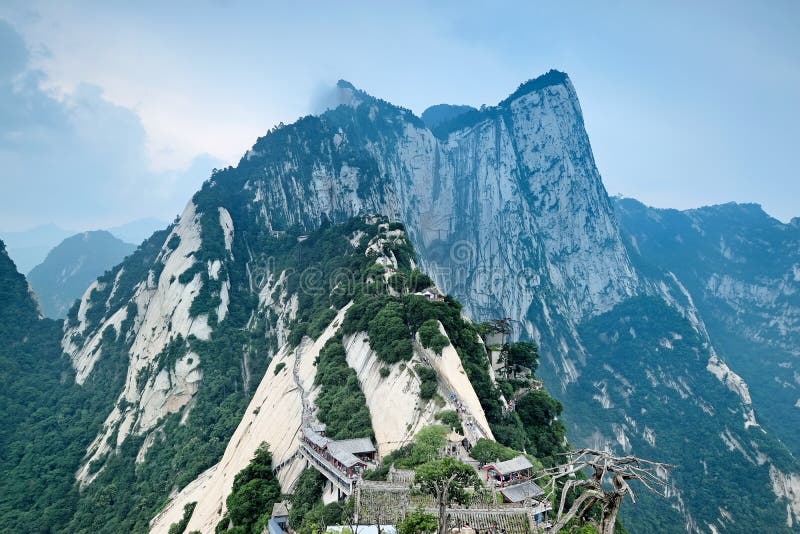
Mount Hua.
Frequently Asked Questions
Frequently Asked Questions about Mount Hua
1. Is Mount Hua suitable for children and the elderly?
While Mount Hua offers breathtaking views and a unique hiking experience, certain trails can be very steep and challenging. Children and elderly individuals should consider their physical fitness and comfort with heights before tackling some of the more strenuous routes. The West Peak Cableway provides an easier way to enjoy the scenery without extensive hiking.
2. Are there English signs and guides available?
Many signs on Mount Hua are in both Chinese and English, particularly in popular areas. However, not all trails may have English signage, so it’s beneficial to have a map or a guide. Hiring an English-speaking guide can enhance your experience, ensuring you don’t miss any key sights or cultural insights.
3. How much time should I plan for a visit?
A typical visit to Mount Hua can take anywhere from 4 to 8 hours, depending on your hiking route and pace. If you plan to explore all five peaks or take part in challenging hikes, consider dedicating a full day to fully enjoy the experience. If you opt for the cable car, you may complete your visit in a shorter timeframe.
4. What are the best times of year to visit Mount Hua?
The ideal times to visit Mount Hua are during spring (March to May) and autumn (September to November) when the weather is mild and the views are spectacular. Summer can be crowded and hot, while winter temperatures can drop significantly, making some trails more difficult.
5. What should I wear and bring for the hike?
Wear sturdy hiking boots and comfortable, layered clothing, as temperatures can vary greatly with altitude. Don’t forget to bring plenty of water, snacks, sunscreen, and a first-aid kit. If you plan to hike challenging routes, a pair of gloves may also be helpful for gripping chains and handles.
6. Are there accommodations near Mount Hua?
Yes, there are various accommodation options near Mount Hua, ranging from budget hostels to more comfortable hotels. Staying overnight can provide you with the opportunity to catch sunrise views from East Peak, which is highly recommended.
7. Can I access Mount Hua by public transport?
Absolutely! The most convenient way to reach Mount Hua is by taking a high-speed train from Xi’an North Railway Station, which takes about 30 minutes. Free shuttles from Huashan North Station will take you to the mountain entrance. Other transport options, like regular buses, are available but take longer.
8. Are there any safety precautions I should be aware of?
Mount Hua’s trails can be steep and narrow, so it’s essential to stay cautious. Make sure to follow marked paths, use safety harnesses on challenging routes, and be mindful of weather conditions. If you’re unsure about any trail, consider seeking advice from park staff or your guide.
Final Thoughts on Your Trip
As your adventure on Mount Hua comes to a close, take a moment to reflect on the incredible journey you’ve experienced. Whether you tackled the thrilling Plank Walk in the Sky, marveled at the serene beauty of ancient Taoist temples, or stood in awe atop the South Peak, each moment has contributed to a tapestry of memories that are uniquely yours. The breathtaking vistas, the thrill of challenging hikes, and the rich cultural history of this sacred mountain create an unforgettable experience that resonates long after you’ve left its trails.
Remember, Mount Hua is not just a destination; it’s an invitation to connect with nature, push your limits, and immerse yourself in the profound spirituality that has drawn pilgrims and adventurers for centuries. As you descend, carry the spirit of the mountain with you, inspiring future journeys and adventures. Embrace the stories waiting to be written, both on the trails and beyond. Safe travels, and may your next adventure be just as exhilarating!